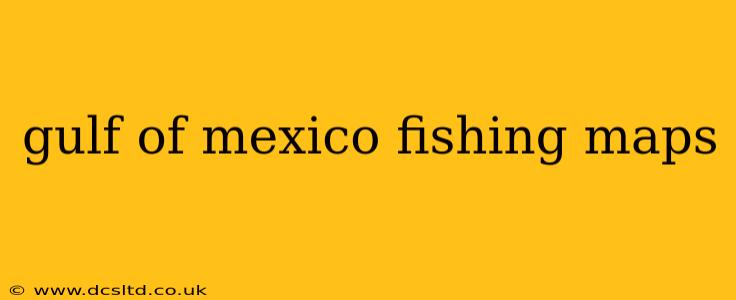The Gulf of Mexico, a vast and diverse body of water, offers unparalleled fishing opportunities. From inshore flats teeming with speckled trout and redfish to offshore reefs brimming with snapper and grouper, the Gulf is a fisherman's paradise. However, navigating this expansive area effectively requires knowledge and the right tools. This guide will explore the best resources for finding the ideal fishing spot in the Gulf of Mexico, addressing common questions anglers have about Gulf fishing maps.
What are the best Gulf of Mexico fishing maps?
There's no single "best" map, as the ideal choice depends on your specific needs and location within the Gulf. However, several excellent resources cater to various fishing styles and preferences. Many anglers utilize a combination of resources to maximize their chances of success.
Electronic Chartplotters: These integrated navigation systems, often found on fishing boats, provide detailed bathymetric charts, allowing you to identify underwater structures like reefs, wrecks, and drop-offs—all prime fishing locations. Popular brands include Garmin, Lowrance, and Humminbird. These systems often allow for the integration of user-generated waypoints and fishing hot spots, creating a personalized fishing map over time.
Paper Nautical Charts: While less convenient than electronic charts, paper charts offer a backup option and can be invaluable in areas with poor GPS signal reception. The National Oceanic and Atmospheric Administration (NOAA) produces detailed nautical charts for the entire Gulf. These charts show water depths, navigational hazards, and other important information for safe and effective navigation.
Online Fishing Maps & Apps: Numerous websites and apps provide interactive fishing maps with user-generated content. These platforms allow anglers to share their catches, mark fishing spots, and access information about local fishing regulations. Examples include Navionics, Fishing Points, and Fishidy. Be sure to check reviews and consider the reliability of user-submitted data.
What are some good resources for finding fishing spots in the Gulf?
Beyond maps themselves, several resources can enhance your Gulf fishing experience:
- Local Fishing Reports: Check local fishing reports from reputable sources like news websites, fishing forums, and tackle shops. These reports often provide real-time information on fish species, locations, and fishing conditions.
- Fishing Guides: Consider hiring a local fishing guide, especially if you're unfamiliar with the area. Experienced guides possess intimate knowledge of the best fishing spots and techniques for a particular region.
- Tide Charts: Understanding the tidal patterns is crucial for successful fishing in the Gulf. Numerous websites and apps provide accurate tide predictions, helping you plan your fishing trips for optimal conditions.
- NOAA Weather Forecasts: Always check the NOAA weather forecast before heading out. The Gulf's weather can change rapidly, and safety should be your top priority.
Are there free Gulf of Mexico fishing maps available?
While some features of online mapping services might require a subscription, many free resources exist. NOAA's nautical charts are freely accessible online, although you might need to download and print them. Some basic fishing map apps also offer limited free functionality, although full access may require a purchase. Remember, free resources may not include all the advanced features offered by paid options.
How accurate are online Gulf of Mexico fishing maps?
The accuracy of online fishing maps varies significantly. While some maps rely on crowdsourced data, providing a general overview of popular spots, others integrate more precise information, such as bathymetry and depth contours. Always cross-reference information from multiple sources to get a better idea of the potential accuracy. Remember, conditions change; user-submitted data may not reflect current fishing conditions.
What features should I look for in a good Gulf of Mexico fishing map?
A comprehensive Gulf fishing map should ideally include:
- Detailed Bathymetry: Clear depiction of underwater contours and depths is crucial for identifying potential fishing structures.
- Navigation Markers: Clearly marked navigational aids, like buoys and channels, are essential for safe navigation.
- User-Generated Content: The ability to see and contribute to marked fishing spots can be invaluable.
- Integration with GPS: Seamless integration with your GPS device enables accurate location tracking and waypoint marking.
- Tide & Weather Integration: Access to real-time tide and weather data helps anglers make informed decisions.
By utilizing a combination of the resources mentioned above, and by understanding the limitations of each, you can significantly improve your chances of a successful fishing trip in the magnificent Gulf of Mexico. Remember always to check local regulations and practice responsible fishing techniques.
